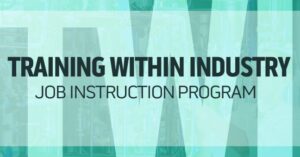
As Vermont manufacturers work to adjust to the new normal, business leaders are finding value in improved employee relationships as we return to work, along with the ever-present need for standardized training and instruction.
VMEC’s Training Within Industry (TWI) programs offer opportunities to expand supervisor knowledge in the areas of Job Instruction (JI) and Job Relations (JR). Let’s take a look at these two methodologies and the ways they might help your business achieve a higher level of collaboration and production.
Considered by some to be the roots of Lean Manufacturing, TWI emerged in the run up to World War II as American manufacturers struggled to meet the crushing demand for all manner of military-related products. As farmers, office workers, and others made their way into factories in support of the effort, there was an urgent need to enable these new workers to transition into new roles. Initially, TWI offered three sessions (known as J sessions): Job Instruction, Job Relation, and Job Methods. This post will focus on the first two.
JI focuses on how to teach someone to do a job correctly, safely, and conscientiously. It is more than just training, as it lets the organization establish stability in the process of getting work done. At the task level, people will naturally do things differently. Without a measure of stability, process variation has the potential to wreak havoc on quality and production schedules. In response, JI teaches a four-step method for giving good instruction:
- Step 1: Prepare the Worker – Describe the task, determine what they already know
- Step 2: Present the Operation – Tell, show, and illustrate, one key step at a time
- Step 3: Try Out Performance – Give them a chance to try the task, correct any errors
- Step 4: Follow Up – Give them the freedom and responsibility of working on their own
JI also covers the necessary preparation before instruction, helping the trainer develop a trainer’s script/job breakdown (sometimes called JIB) that aligns with standard operating procedures (SOPs), etc. The script is particularly important. This document—typically just one page—captures the important steps, along with the key points for each step, and why they are important. Think of the steps as what you do, the key points as how, and the compelling reasons as why.
JR meanwhile, stresses the need for strong relations between workers and supervisors. Leaders, after all, get things done through people, whether they are direct reports, counterparts in other departments, or even superiors.
JR views each of these relationships as two-way exchanges. Leaders, after all, can’t approach all relationships from a position of superiority; the exchange must flow in both directions. What’s more, JR emphasizes the need to establish strong foundational relationships before problems arise. In this way, the existing respect and trust form a starting point for effective resolution. Much like JI, JR has its own four-step engagement process:
- Step 1: Get the facts – Gather the whole story through conversation and a review of the important data
- Step 2: Weigh and decide – Identify possible actions and weigh them against your objectives
- Step 3: Take action – Decide who is the best person to handle the situation (keeping in mind that it may or may not be you)
- Step 4: Check results – Determine if the actions taken helped or hindered production
These concepts and steps are the basis of the training; like so many other new skills, true mastery comes through study, practice, and application of the lessons learned.
TWI in Practice 
So how does the application of TWI benefit small- and medium manufacturers?
Darci Ruggles, Director of Corporate Quality Management Systems for Momentum Manufacturing Group, a St. Johnsbury-based specialty contract manufacturer, is a veteran of VMEC’s TWI training and shared her experiences with the process.
She says the company first approached VMEC about TWI several years ago. But when she saw the announcement for JI/JR training at a time when the company had some new supervisors coming on board, she knew it was time to learn more about improving relations and helping supervisors get better.
Momentum began with JR, and following the success of that training, they sent some of the same individuals (along with a few new ones) to JI. She says one of the key benefits was the opportunity to standardize training across the company’s seven manufacturing sites.
From a quality standpoint, JI has elevated the level of training among engineers who instruct others in the use of some measurement equipment. For both new and veteran workers, though, establishing specific, standardized training has made that gauge usage and similar tasks more seamless.
“It was important that these new hires understand how to train people,” Ruggles says. “There are specific training steps [at Momentum] so everyone learns the same way regardless of where they work.”
Ruggles adds that the JR trainees do a measurably better job managing their charges and defusing issues, which was a new responsibility for some. “I think it’s helping them step back and figure out how to go about correcting employees,” she says.
When asked why Momentum selected VMEC as a TWI training provider, she says this is the latest in a long educational partnership. “We’ve used [VMEC] a lot, honestly,” she says. “They’re my first stop when I’m looking for something. I know they will connect me with a solid resource if they don’t have the skill in-house.”
The Experts Speak Out 
Susan Janus, founder of Deeper Thinking, LLC and a VMEC TWI instructor, brings decades of experience to her instruction, having been involved in some of the MEP network’s first TWI workshops. Today she speaks widely on the topic and says that one common factor among many industries is the notion of the practitioner who becomes a leader, and the problems that can result.
“People train to be an engineer or nurse, or something else, and then they become a leader,” she says. JI and JR create a standard to work to, enabling those individuals to improve their performance in leadership roles.
In the case of JR, for instance, we learn specific strategies for showing respect through our interactions.
“Our jobs as leaders are complex. Challenges arise daily that can result in people problems. JR provides a 4-step routine that when followed results in effective actions to resolve problems. The process will help leaders to identify root causes that when addressed will benefit the whole organization. When you look at the steps, they seem obvious, but they are things we often overlook. Rather than gathering the facts, we jump to conclusions; instead of taking action, we pass the buck, and so on. JR gives you a standard to approach these things.”
Janus reiterates that JR is a skill that must be practiced, which runs counter to the notion that leaders are charismatic people who should have a natural ability to deal with others.
“JR teaches Foundations for Good Relations that will prevent people problems from arising,” she says. They include: Let each worker know how he/she is doing; Give credit when due; Tell people in advance about changes that will affect them; Make best use of each person’s ability. “These foundations can be applied daily to keep job relations strong, straight and correct; relations that flow in both directions. Getting to know people as individuals helps to build relationships built on mutual trust and respect.”
Reflecting on how problems arise allows leaders to identify foundations that need to be strengthened at all levels of the organization and also, opportunities to further develop their skill in effectively resolving people problems. When first starting out, new leaders often find they are “running right into” problems that elevate emotion and complexity as well as repeat over time. These problems are difficult to solve. With practice, leaders can learn how to anticipate and prevent problems from arising.
Following the basic principles of JR, though, creates a pattern of thought that can enable effective interactions. When presented with a problem, JR practitioners ask first what they want to accomplish; they ask good questions and listen to understand before deciding what action to take. After addressing the issue, they follow up to determine the effectiveness of the action taken and that the objective was met.
“After all, everything you try to accomplish in your career is done through people,” Janus says. “Whether they report to you, they are your colleague, or they are your superior. It’s not enough to gain some knowledge through training. The transformative piece of TWI is the implementation and application. Using the skills taught in these workshops can become a company’s competitive advantage.”
Phil Chadderdon, a VMEC Professional Manufacturing and Business Growth Advisor, is another of our subject-matter experts who delivers training in both JI and JR. Phil says he became a TWI practitioner later in his career and had to learn a lot of lessons the hard way; that’s one reason he enjoys sharing these strategies. When asked why a customer would consider TWI, he echoes Susan’s words.
“You, as a supervisor—or anyone who directs the work of others—get results through people. JR in particular enables improved communications, better morale, and fewer ‘people problems.’ What’s more, when those problems do come up, they can be dealt with more easily.
“Addressing the problem early can mean the difference between extinguishing a fire with a cup of water versus having to call the fire department.”
Hurdles Remain, from Culture to Employee Pipelines
Given the need to see TWI as an applied learning program, our learn-by-doing workshop offers the chance to drive the principles home. “That’s different than a lot of training approaches,” Chadderdon adds. “You don’t sit there and absorb, then go home with a book full of notes. You learn and then start using it in practice right away in the session. Attendees receive a letter in advance of the training that describes the learn-by-doing nature and tells them they will be working on actual problems during the class.”
If the standard work made possible through JI, or the minimized personnel issues methodologies promised by JR sound like a wise investment for your business, you can learn more about VMEC’s TWI training offerings here.


